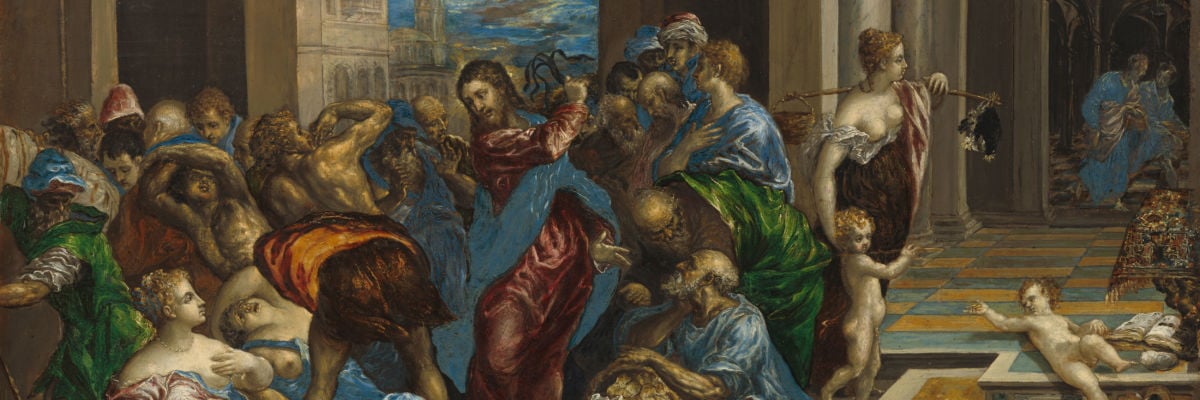
Homily for the Third Sunday of Lent, Year B
Since the Passover of the Jews was near,
Jesus went up to Jerusalem.
He found in the temple area those who sold oxen, sheep, and doves,
as well as the money changers seated there.
He made a whip out of cords
and drove them all out of the temple area, with the sheep and oxen,
and spilled the coins of the money changers
and overturned their tables,
and to those who sold doves he said,
“Take these out of here,
and stop making my Father’s house a marketplace.”
His disciples recalled the words of Scripture,
Zeal for your house will consume me.
At this the Jews answered and said to him,
“What sign can you show us for doing this?”
Jesus answered and said to them,
“Destroy this temple and in three days I will raise it up.”
The Jews said,
“This temple has been under construction for forty-six years,
and you will raise it up in three days?”
But he was speaking about the temple of his body.
Therefore, when he was raised from the dead,
his disciples remembered that he had said this,
and they came to believe the Scripture
and the word Jesus had spoken.While he was in Jerusalem for the feast of Passover,
many began to believe in his name
when they saw the signs he was doing.
But Jesus would not trust himself to them because he knew them all,
and did not need anyone to testify about human nature.
He himself understood it well.-John 2:13-25
I can remember occasions, as a child, when my parents only had to show the instrument of punishment to correct me. Just the sight of my dad’s belt or of a carefully stripped wooden switch from the backyard was enough to make me behave.
Our Lord, St. John tells us today, made a whip out of cords and drove the money changers and sellers out of the temple precincts. Imagine how perfect and effective a whip made by the Savior and Creator would be. Pretty scary altogether.
Strangely enough, in the Catholic and Orthodox Churches, in which there are traditionally venerated relics of practically every aspect of Our Lord’s life, there never have been any relics of the whip he made. (Believe me, I’ve done the research and come up with nothing; if any readers have any leads, let me know!) St. Thomas Aquinas and Bl. Anne Catherine Emmerich tell us that it is reasonable to assume that the Cleansing of the Temple was a miracle, a “sign” on account of which some believed in Jesus, as today’s Gospel indicates.
Consider that it would have been impossible to drive out so large an assemblage of men and animals and furniture, unless it were by some miraculous power. One should consider also that Our Lord would not have done physical violence to anyone, or need to. He was never in extremes. So, like little me with my parents, his appearance and that of his whip was more than enough to set them all running. They certainly did not wait to find out what might follow. So it was a miracle perhaps, but a very understandable one.
Why was he so angry? After all, there were certainly evils that were greater in Israel in Our Lord’s time. I think a little reflection on the concrete reality of Our Lord’s humanity can help us to answer this question.
The Venerable Mary of Agreda depicts Our Lady and St. Joseph tidying up the cave of Bethlehem in which were found surely sheep and oxen and doves as a kind of prefiguration of the cleansing of the temple. In preparation for the Lord’s birth, they put everything in order to the amazement of the holy angels, “cleansing the temple” where he was to be born and first worshipped. Forty days later, the Holy Family was in the temple for the purification of Our Lady and his presentation.
What a different scene from the cave of Bethlehem as Joseph purchased the two turtledoves—the offering of the poor who could not afford a goat or a sheep—and was cheated in the exchange of coins, as were many of the poor of Israel! Then imagine how often the Holy Family went to offer the paschal sacrifice at Passover and other sacrifices as their devotion moved them. They were cheated a bit along with everyone else. Their worship was pure, but they were exposed to the injustice of others who sought profit out of the devotion of the simple.
In short, Our Lord was angry on behalf of his parents whom he honored above all. Consider that his Fathers’ house was not only the heavenly Father’s house, but also his earthly father’s house, where St. Joseph lovingly fulfilled year in and year out the requirements of the law. The Savior took the thievery of the moneychangers personally. He had a zeal for the vindication of justice, which is the very motivation for anger, for the sake of Mary and Joseph.
So when Our Lord corrects us, he does so as a man, a human being. He has genuine emotions, like those of our own parents, only without any imperfection. He has a zeal for his Father’s will and for what is truly good for those whom he loves, and if he seems severe, he still causes a little pain as possible if he has to threaten or frighten us a bit. He really does take our faults personally, but that is because he has a heart that loves us and desires our good.
After all, he calls his own Body the temple of the Lord, and the apostle tells us that our bodies are temples of God, so he sees his Father’s glory and true worship in us, and is saddened and even angered to see his temple desecrated by our sins. He enters there anyway, and performs, over and over again in the course of our lives his work of cleansing and perfecting us.
But even more consolingly, he defends us from anyone who might want to harm or trouble us. In his zeal for the honor of his Father’s house he has zeal for our own honor as his true temples, so we have in Jesus both our most relentless corrector, and our truest and eager defender. May we never feel the lash of his wrath without knowing that it is the blow of his personal love for us, his and his Father’s true temples!



